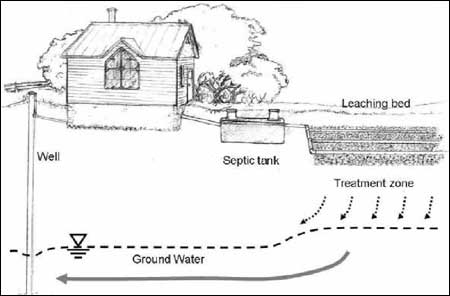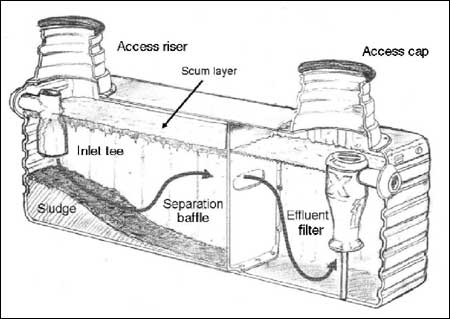What is a Septic Systems
If you live in a rural area, chances are you have a septic system. Septic systems are onsite wastewater systems that treat your sewage right on your own site and releases the treated effluent back into the ground eliminating the need for municipal sewer systems in rural areas.
 How does it work?
How does it work?
The most common system consists of a septic tank and leaching bed, all of which are hidden underground. All wastewater exits your home from a pipe that leads to the septic tank. The tank helps solids separate from liquids and the remaining liquid called effluent moves out of the tank into the leaching bed and lets the liquid seep into the ground where bacteria and other organisms process the wastewater and filter it into the ground.
In Ontario, the Ontario Building Code governs nearly all rural septic systems. If you are installing, repairing, upgrading or replacing a septic system you MUST contact your local regulatory agency. It may be your health unit or conservation authority that inspects systems, issues permits, maintains records and enforces part 8 of the Ontario Building Code.
Effluent Filters
An effluent filter installed at the outlet of the septic tank, dramatically improves the quality of effluent being discharged to the leaching bed, effectively extending its life. The addition of an effluent filter to all systems is strongly recommended.
 Sewage enters the first chamber of the septic tank through an inlet baffle or tee. Most of the larger particles settle out and the effluent enters the second chamber. The second chamber (much smaller than the first) further enhances the settling process. If flows are heavy at times, solids can pass through both compartments and enter the leaching bed. The effluent filter minimizes this. Effluent filters have two main purposes: Assist in the settling of both large and small particles, and help slow down flow to further enhance particle settling before damage is done to the leaching bed.
Sewage enters the first chamber of the septic tank through an inlet baffle or tee. Most of the larger particles settle out and the effluent enters the second chamber. The second chamber (much smaller than the first) further enhances the settling process. If flows are heavy at times, solids can pass through both compartments and enter the leaching bed. The effluent filter minimizes this. Effluent filters have two main purposes: Assist in the settling of both large and small particles, and help slow down flow to further enhance particle settling before damage is done to the leaching bed.
Intended Use:
Improves effluent quality.
Extends leaching bed life.
Details:
- Can be used in any septic tank.
- May be installed in a new system, or retrofitted into an existing tank.
- Corrosion proof construction.
- Relatively simple installation.
- Simple maintenance.
- Filters can be equipped with an alarm to warn that filter needs cleaning.
- Custom and standard sizes available from many manufacturers (contact us for a quote).
System Maintenance
| Do | Don't |
|
|





